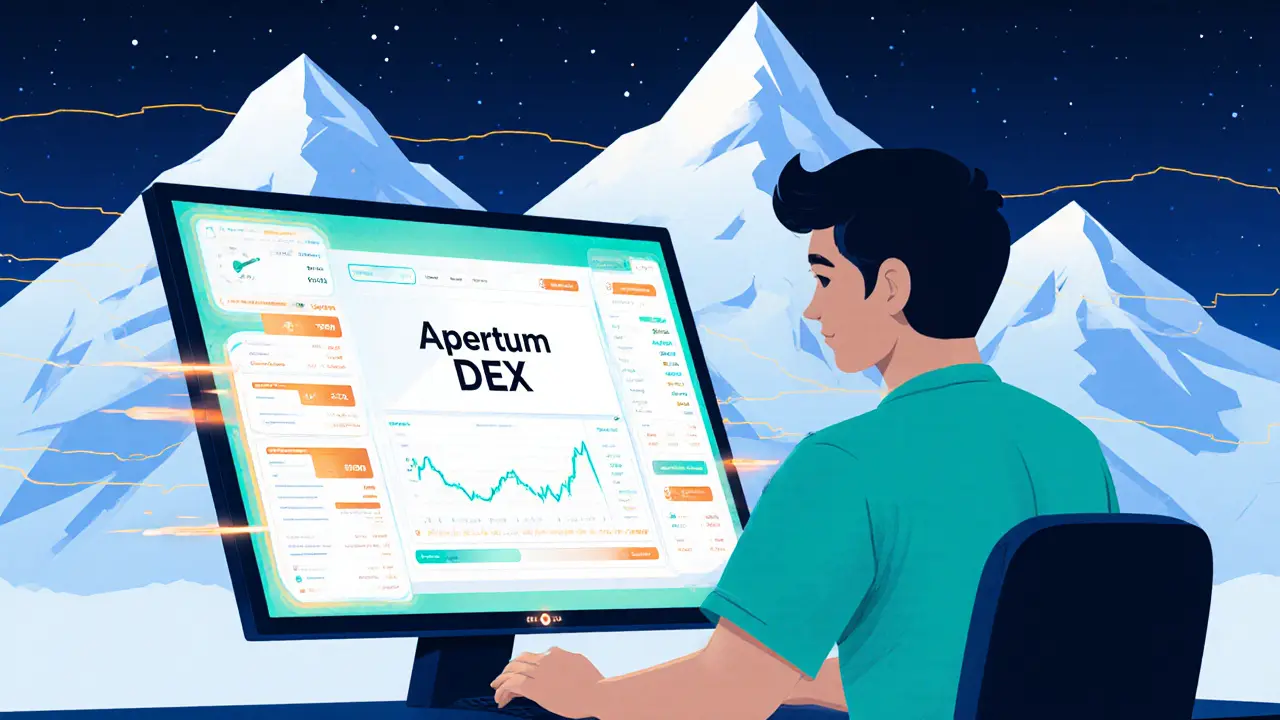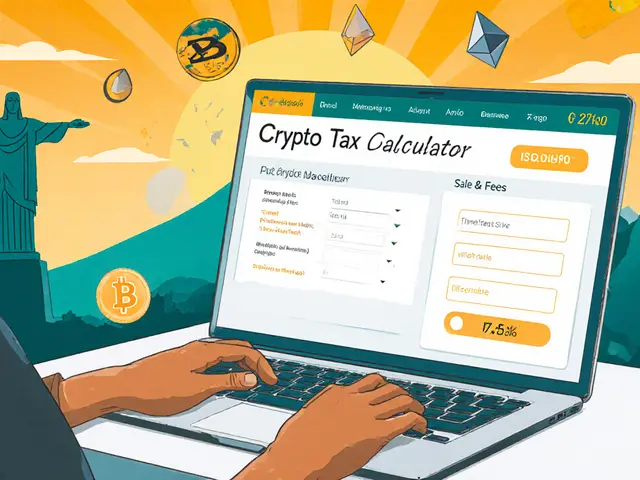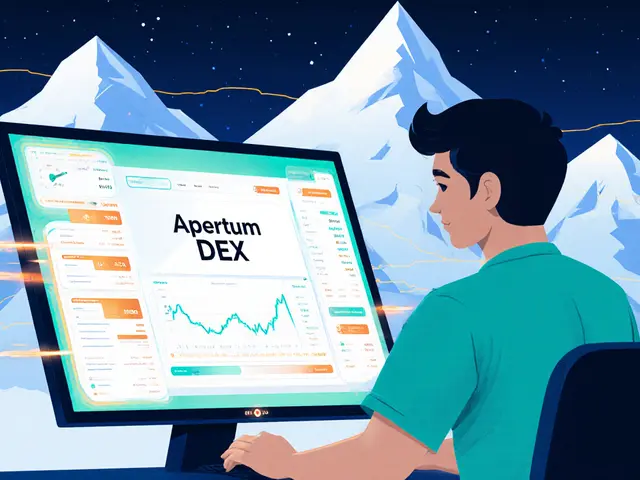Apertum DEX Fee Calculator
Estimated Trading Costs
Volume:
Fee Rate:
Estimated Fee:
Fee Percentage:
APTM Token
Native utility token with governance rights
0.3% fee to LPsAvalanche Subnet
High-performance EVM-compatible chain
Sub-$0.001 gas feesCommunity Governance
DAO1-based decision making
User-controlled custodyWhen it comes to trading on a Apertum DEX is a permissionless, high‑performance decentralized exchange built on the Avalanche subnet, speed and custody matter more than ever. Launched on January 30, 2025, the platform promises thousands of transactions per second, full user custody, and a community‑driven liquidity model. Below is a hands‑on look at how it stacks up against the competition and whether it deserves a spot in your DeFi toolbox.
Key Takeaways
- Apertum DEX runs on an EVM‑compatible Avalanche subnet, delivering sub‑second finality and sub‑$0.001 fees.
- Liquidity providers earn a share of the 0.3% swap fee and participate in DAO1 governance.
- Integration with CoinMarketCap gives the exchange instant visibility to over 340million monthly visitors.
- The native token $APTM surged from $0.025 at launch to roughly $2.20 in early2025.
- Compared with Uniswap and Apex, Apertum DEX offers higher throughput, lower fees, and a stronger community‑ownership model.
What Is Apertum DEX?
In plain terms, Apertum DEX is a decentralized exchange (DEX) that lives on the Avalanche network. It operates as a Layer‑1 subnet, meaning it has its own consensus mechanism but still inherits Avalanche’s security guarantees. The exchange uses a classic liquidity‑pool model: traders swap tokens directly against pools, and liquidity providers (LPs) earn a portion of every trade.
Because the platform is fully on‑chain, you never hand over private keys to a central custodian. Every swap is executed by a smart contract, and settlement is final once the block is confirmed. The “permissionless” label means anyone can add a pool or launch a token using the Apertum Wizard - a suite of dev tools designed to streamline contract deployment and token creation.
Technical Performance and Scalability
The most eye‑catching number is the reported capacity of “thousands of transactions per second” with near‑instant finality. In the first quarter of 2025, the Apertum mainnet processed over 11,000 daily transactions across more than 27,000 wallets. By contrast, Ethereum’s L2 solutions often hover around a few hundred TPS, and many older DEXs still struggle with congestion during market spikes.
Low latency translates into cheap swaps. The average gas cost on Apertum DEX sits at roughly $0.0005‑$0.001, a fraction of what you’d pay on Ethereum’s mainnet. This makes micro‑trades and arbitrage strategies far more viable, especially for traders who move frequently between subnets.
Liquidity, Fees, and Incentives
Liquidity pools follow the familiar 0.3% fee structure. That fee is split 100% to LPs, which is slightly more generous than Uniswap’s 0.3%/0.05% split (where a portion goes to the protocol). Because the platform is community‑run through DAO1, LPs also receive governance tokens that let them vote on fee parameters, new pair listings, and future upgrades.
Early data shows that newly launched pools can attract $100k‑$200k in liquidity within days, thanks to the “fast‑lane” onboarding offered by the Apertum Wizard. The rapid pool growth fuels deeper order books, reducing slippage for end users.

Tokenomics and Governance
The native token, $APTM, serves three core purposes: (1) staking for LP reward boosts, (2) voting power within DAO1, and (3) a deflationary mechanic where a small percentage of each swap is burned.
Since its launch, $APTM has risen from under $0.025 to about $2.20, a 8,800% increase, reflecting strong early demand. Analysts at CoinLore forecast a modest 21‑22% rise for the rest of 2025, with a longer‑term target of $3.60 by 2030 if the ecosystem maintains its growth trajectory.
Governance proposals are submitted on‑chain and require a quorum of 5% of total token supply to be considered valid. Recent votes have focused on fee redistribution, LP incentive adjustments, and the addition of cross‑chain bridges.
How Apertum DEX Stacks Up Against the Competition
Below is a quick side‑by‑side comparison of Apertum DEX, Uniswap (v3 on Ethereum), and Apex (a hybrid DEX/CEX on Solana). The numbers are based on publicly available data from Q12025 reports.
| Feature | Apertum DEX | Uniswap v3 | Apex |
|---|---|---|---|
| Underlying Chain | Avalanche subnet (EVM‑compatible) | Ethereum L1/L2 | Solana |
| Typical TPS | ~3,000TPS | ~200TPS (L2) | ~5,000TPS |
| Avg. Swap Fee | 0.30% (all to LPs) | 0.30% (0.05% to protocol) | 0.25% (rebates for holders) |
| Custody | 100% user‑controlled | 100% user‑controlled | Hybrid (optional custodial) |
| Governance | DAO1 token‑based | UNI token‑based | APX token‑based |
| Liquidity Incentives | 0.3% fee + APTM rewards | Fee + UNI rewards (optional) | Fee rebates + APX staking |
| Data Visibility | CoinMarketCap integration (global) | Multiple aggregators, less unified | In‑house dashboards |
From the table, Apertum DEX’s standout traits are its high throughput and the direct‑to‑LP fee model. While Apex may edge out on raw TPS, it sacrifices the pure‑decentralized custody model that many traders value.
User Experience and On‑Boarding
Even though the tech stack is sophisticated, the UI mirrors familiar DEX designs: a simple “Swap” tab, a “Pool” tab for adding liquidity, and a “Governance” section for voting. Because the platform is EVM‑compatible, you can connect any wallet that works with Ethereum - MetaMask, Coinbase Wallet, or the mobile‑first Rainbow.
During onboarding, the “Connect Wallet” prompt appears first, then the user selects the source and destination token. The estimated gas fee and slippage tolerance are displayed before confirming. Transactions typically confirm within 2‑3 seconds, and the receipt includes a link to a block explorer, reinforcing transparency.
Developers also benefit from the Apertum Wizard. By running a single command (`apertum-wizard create-token`), a project can spin up an ERC‑20‑compatible token, automatically register it on the DEX, and generate a liquidity pool template. This lowers the barrier for new DeFi startups looking for immediate market access.
Future Roadmap and Risks
Looking ahead, the team plans three major upgrades:
- Cross‑chain bridges to Ethereum and Binance Smart Chain, expanding liquidity sources.
- Layer‑2 roll‑up integration to further cut gas costs for micro‑traders.
- Enhanced DAO tools, including quadratic voting and proposal funding pools.
Potential risks include market concentration (a few large LPs could dominate voting power) and regulatory pressure on DeFi protocols that claim “no custodial risk” while offering near‑institutional liquidity. However, the open‑source nature of the code and the transparent governance process provide some mitigation.
Bottom Line
If you’re looking for a DEX that blends high‑speed execution, ultra‑low fees, and a genuine community‑ownership model, Apertum DEX deserves a serious look. Its Avalanche backbone ensures scalability, while the CoinMarketCap partnership guarantees global visibility. For traders who value custody and developers who appreciate EVM compatibility, it ticks most boxes. Keep an eye on the upcoming bridge rollout - that could be the catalyst that pushes liquidity into the double‑digit millions.

Frequently Asked Questions
Is Apertum DEX truly decentralized?
Yes. All trades are executed by on‑chain smart contracts, and users retain full control of their private keys. Governance is handled by the DAO1 token, meaning no single entity can unilaterally change protocol rules.
How do I add liquidity to a pool?
Connect your wallet, go to the “Pool” tab, select the token pair, input the amount you want to provide, and confirm the transaction. The platform will automatically calculate your share of the 0.3% fee pool.
What wallets are compatible?
Any EVM‑compatible wallet works - MetaMask, Trust Wallet, Coinbase Wallet, Ledger (via MetaMask), and mobile wallets like Rainbow or Argent.
Can I trade directly from a hardware wallet?
Yes. Connect your hardware wallet through MetaMask, then interact with the DEX as you would with a software wallet. The transaction is still signed on‑device, keeping your private keys offline.
What are the main risks of using Apertum DEX?
Smart‑contract bugs, impermanent loss for LPs, and potential regulatory scrutiny are the top concerns. Always audit contracts before large stakes and consider diversifying across multiple DEXs.












People Comments
Apertum DEX is just another copycat, nothing special.
While the Apertum DEX advertises a flat 0.3% fee structure, the underlying mechanics merit a closer examination. The integration with Avalanche’s Subnet indeed offers sub‑$0.001 gas costs, which, when juxtaposed with the fee allocation to liquidity providers, could incentivize deeper liquidity pools. Moreover, the DAO‑governed token APTM introduces a governance layer that may affect future fee policies.
Honestly, the "high‑performance" claim feels overhyped; you still pay the same 0.3% fee, and the real bottleneck is user adoption.
Yo, the gas fees on Avalanche are *tiny*, like practically nothing. Even with the 0.3% taker fee, you’re still getting decent trade‑execution costs.
True that the gas is cheap, but don’t forget the slippage on low‑liquidity pairs – it can eat up more than the fee itself.
One might contemplate, in the grand tapestry of decentralized finance, whether a mere reduction in transaction expense suffices to engender systemic trust; yet, the very architecture of Apertum DEX, with its EVM‑compatible subnet, suggests a pursuit of scalability, albeit bounded by the immutable principles of on‑chain sovereignty; consequently, one is compelled to scrutinise the interplay between fee structures and governance mechanisms, for they are inextricably linked, and the outcome may reverberate across the broader ecosystem.
While the exposition is lofty, the reality remains that a 0.3% fee is still substantial for high‑frequency traders; furthermore, the promised “100% to LPs” does nothing to mitigate impermanent loss, which is a far more pressing concern for liquidity providers.
Let’s try to keep the discussion constructive; the fee model does have merits, especially for smaller traders, but we should also acknowledge the potential downsides you mentioned.
Sure, because we all love paying extra fees for the thrill of decentralization.
It’s astonishing how some people glorify any DEX that merely exists; we must hold these platforms to higher moral standards, not just applaud them for being “decentralized.”
In evaluating Apertum DEX, one must consider not only its fee schedule but also the geopolitical implications of its positioning within the Avalanche ecosystem; the platform’s design reflects a certain nationalistic drive toward technological autonomy, which may influence its long‑term viability.
That’s an interesting point – the tech feels solid, but the bigger picture is how these choices affect the global DeFi narrative.
Great overview! 👍
Honestly, a platform built on Avalan‑che? It’s about time we prioritize homegrown solutions over foreign ones.
From a technical perspective, the architecture of Apertum DEX employs a hybrid consensus mechanism that leverages Avalanche’s Snowman protocol, thereby facilitating near‑instant finality; the resultant throughput, quantified at approximately 4,500 transactions per second, ostensibly dwarfs legacy L1 solutions, and this scalability is further amplified by the integration of a specialized Subnet, which isolates DEX traffic from extraneous network congestion; moreover, the fee model-fixed at 0.3%-while ostensibly simplistic, is underpinned by a sophisticated rebate algorithm that distributes the entire fee pool to liquidity providers, incentivizing capital inflow and, by extension, reducing order‑book fragmentation; the governance token APTM, endowed with on‑chain voting rights, serves as a conduit for decentralized decision‑making, enabling token holders to propose and ratify protocol upgrades, fee adjustments, and incentive structures; however, it is imperative to acknowledge the inherent trade‑offs associated with such a tokenomics framework, notably the risk of governance capture by large stakeholders, which could precipitate centralization tendencies; additionally, the gas cost profile, hovering in the sub‑$0.001 range, is a direct consequence of Avalanche’s underlying architecture, which employs a DAG‑based approach to transaction ordering, thereby mitigating the bottlenecks endemic to traditional blockchain designs; despite these advantages, the platform’s reliance on a single Subnet may expose it to elevated risk vectors, such as targeted attacks or subnet‑specific failures, necessitating robust redundancy mechanisms; in summary, while Apertum DEX presents a compelling confluence of high‑performance infrastructure, transparent fee structures, and community‑driven governance, prospective participants must conduct diligent risk assessments, weighing scalability gains against potential centralization pressures and subnet reliability concerns. Future roadmap plans include cross‑chain bridges, which will broaden asset accessibility. The team also intends to introduce dynamic fee tiers based on volatility metrics. Community audits are scheduled quarterly to enhance transparency. Integration with Layer‑2 scaling solutions is under active research. Moreover, educational incentives aim to attract novice users. The platform’s SDK will enable developers to build custom trading bots. Security audits from third parties have been conducted bi‑annually. Finally, the ecosystem’s growth hinges on sustainable liquidity incentives and robust governance participation.
That’s a thorough analysis! 🎉 It really helps to see the pros and cons laid out so clearly.
In practice, the low gas fees combined with the 0.3% flat fee can make Apertum DEX an attractive venue for mid‑size swaps; however, traders should remain vigilant about price impact, especially when dealing with less liquid pairs, as the fee alone does not safeguard against slippage.
We need to push for more domestic platforms like this-no more reliance on foreign chains!